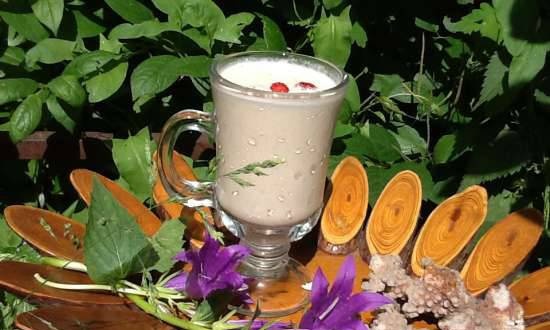The starter culture can be stored in the refrigerator (+4) for a very long time, you only need to refresh it once a week. Sourdoughs dominated by MCB are the most resistant to infections.
I bring to your attention questions and answers about ferments. The questions are answered by G.V. Ternovsky, Ph.D. Deputy Director of the St. Petersburg branch of the State Scientific Institution of the State Scientific Research Institute of the Bakery Industry of the Russian Academy of Agricultural Sciences. Grigory Valerievich has been deeply engaged in microbiology of a narrow focus for 12 years - as applied to the baking industry. In our vast country, there are literally a few specialists who deal only with this problem.
1. Does the way (method) of rye sourdough breeding affect its baking qualities?
Yes, it does. Temperature, humidity (dry matter content), i.e. amount of flour, consistency.
The higher the operating temperature, the higher the acidity, more lactic acid bacteria, less yeast, less carbon dioxide, low looseness.
The lower the humidity, the higher the acidity - there is less yeast than in a more liquid sourdough at the same temperature; lactic acid bacteria are about the same or slightly more than in a more liquid sourdough at the same temperature.
2. Will the composition of the microflora of the sourdoughs differ, produced by different methods, but using the same flour and water?
Depending on the temperature and humidity of the starter, microorganisms (lactic acid bacteria, yeast) for which these (different methods) conditions are optimal (or close to them) growth conditions will be dominant.
3. Can you recommend a basic method of sourdough removal, which will provide the sourdough that is the most suitable in microflora for baking rye bread, the most resistant to infection, the most unpretentious and the most long-lived when preserved? Is there such a method?
Leading temperature - 38-42 degrees, humidity - 63-70%, fermentation duration 12-24 hours. Renewal 1 (leaven): 1-3-5 (wheat nutrition) 1 (leaven): 3-9 (rye nutrition). The constant renewal of spontaneous starter culture will sooner or later lead to the replacement of the microflora of the starter culture with the microflora of flour introduced with nutrition.This method allows you to reduce the likelihood and "delay" the moment of displacement, because in this mode, ferment microflora prevails - lactic acid bacteria, which suppress weaker and acid-labile yeast with accumulating high acidity, and self-preserving weaker lactic acid bacteria introduced with flour upon renewal.
4. What is the main reason for the microbiological composition of the spontaneous fermentation starter culture?
Microbiological composition of grain and flour, from which a water-flour suspension is prepared. It also depends on the temperature of the feed, the moisture content of the starter, the quality of the flour in the nutrient mixture (chemical composition: minerals - the lower the grade, the higher, the enzymatic activity - grinding, grain quality.)
5. What sourdough, or what properties of the sourdough (or microbiological composition) determine the taste of Russian rye bread?
The taste of rye bread is determined by substances that accumulate during the fermentation of sourdoughs - lactic and acetic acid, alcohol (ethanol and other aromatic), aldehydes, volatile organic acids - propionic, formic, etc. Sourdoughs prepared in different ways - thick, liquid with brewing or without, thermophilic fermented tea leaves and other technologies used in industry have contributed to the formation of the taste and smell of "Russian rye bread".
6. To what extent and in what way can the starter cultures bred at home differ according to the same method, but in different regions, for example, in Russia, Germany and Canada?
They will differ in microflora, and, accordingly, in quality indicators (acidity, lifting force, ratio of LAB and yeast, content of lactic and other acids, alcohol), which in turn affect the quality of finished products.
7. What happens to the leaven that gets "permanently" from one region to another? The answer to this question will help us understand whether we should exchange leaven?
It's all about the flour used, different flour (grain) - different microflora - different quality sourdough. The leaven will be different.
8. What is the difference in chemical and microbiological composition between rye and wheat leavens?
On chemical - depending on the chemical. flour composition.
Microbiological:
- lactic acid bacteria: depending on humidity and temperature - in wheat and rye starter cultures prevail - thick: L. plantarum, L. brevis, L. paracasei; liquid: L. fermentum, L. casei, L. plantarum.
Yeast - wheat - mainly - S. cerevisiae; in rye, mainly C. milleri; and not significantly - S. cerevisiae, when using infusions mainly S. cerevisiae.
9. Are there conditions, the observance of which can guarantee a home baker to obtain a leaven, in which the lactobacilli necessary for baking Russian rye bread will dominate?
See above # 3. No guarantee. More likely to have a positive outcome.
10. We are accustomed (from practice) to believe that spontaneously fermented wheat sourdough freshly bred according to one method or another has certain unique qualities for this method, which disappear very quickly as soon as the sourdough undergoes cycles of conservation and de-conservation. The taste of wheat bread with such a sourdough, very rich with fresh sourdough, quickly depletes. The taste of rye bread on spontaneous fermentation rye sourdough is stable even with multiple cycles of preservation and re-preservation of the leaven.
In wheat, as well as in rye, during conservation, the microflora is stressed and the equilibrium combination of yeast and lactic acid bacteria is shifted, and, accordingly, the taste and aroma profile changes. Recovery takes time, or doesn't happen at all. In wheat, recovery is less likely than in rye due to differences in the chemical composition of wheat and rye flour, as well as the prevailing types of microorganisms.
eleven.Does this mean that wheat leaven is a more “tender” substance than rye, or is this a delusion? Or, after all, the microflora of rye leaven is capable of fundamentally changing the taste of bread and the preservation of the established symbiosis of microflora requires the same careful attitude as wheat leaven?
Wheat, usually characterized by less acidity than rye. And therefore, the probability of a change in its quality indicators is higher than that of rye. But this does not mean that she is more "gentle". Sourdough (wheat, rye) is a symbiosis of microorganisms that changes depending on temperature, concentration of food. substances, acidity. In wheat it is higher, more often due to the fact that there are less nutrients than in rye flour.
12. Are there methods (or criteria) for assessing the quality of a leaven, other than appearance and smell, that are acceptable to the home baker to help predict the result of baking using this leaven?
The behavior of spontaneous starter culture cannot be predicted.
Only with an objective (using instrumental methods) assessment of the quality of the sourdough, it is possible to predict its behavior and the final quality of bread. Subjectively, only a very well trained baker can draw conclusions about its quality by taste and smell and, accordingly, predict the outcome.
13. How does the composition of the starter change depending on the increase (decrease) in temperature and acidity of the substrate?
When the temperature rises to 40 ° C, it is better for lactic acid bacteria. More LAB, higher acidity, less yeast.
When reduced to 20-22 ° C, it is better for yeast. More yeast, more looseness, alcohol smell, less MCB.
14. Does it make sense to use pure cultures of yeast and LAB for starter culture at home?
Yes, if there is a possibility of acquisition, the consistency of quality and predictability of the outcome is much higher than when using a spontaneous leaven. But due to discreteness, periodic renewal from pure culture is required once a week, 2 weeks, depending on conditions.
15. Probably, the introduction of a pure culture of lactobacilli into the starter culture will give it unique and predictable properties. In your opinion, is it possible at home for a long time to preserve the starter culture for use on pure cultures?
The introduction will not give. Pure cultures should be introduced into the starter batching cycle and not into the existing starter culture. See # 14.
16. How justified is the method of converting rye sourdough into wheat and vice versa by overfeeding with appropriate flour?
Not justified, different microflora (see # 8), unpredictable quality.
17. Is it possible that the established dominant microflora in rye sourdough will "conflict" with wheat flour if it is overfed into wheat sourdough? For example, is it possible that well-established yeast strains in rye sourdough cannot multiply in wheat flour dough?
See # 16 and # 8. The yeast is different, the competition with the ICD for food is different; taste, smell changes significantly.
18. Are there any peculiarities in the sets of certain microorganisms in rye and wheat leavens?
See # 8
19. Does the microbiological composition of the starter culture change (if so, how) at elevated and low temperatures, for example, at + 30-32C or + 4-8C?
See # 13. At + 4-8 degrees, acidity increases - yeast is inhibited.








